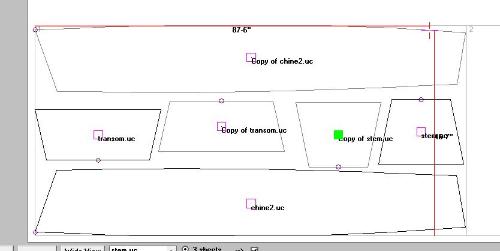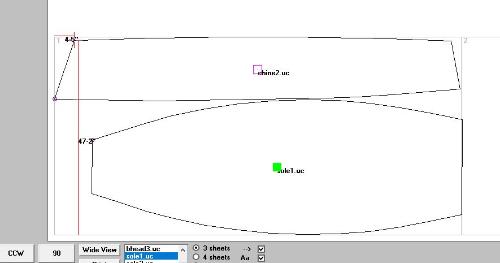A Sheet & a Half Pram
|
This post was updated on .
Many years ago, 'one-sheet' boats were actively drawn and built. Many were clever. Most were impractical, and then the fad died off --as has wooden boat-building generally-- in favor of other hobbies or the convenience of plastic or inflatable boats. But the challenges of "minimalist" building still intrigue me.
Below are the offsets for a 'sheet and a half' pram. I've built a couple along similar lines, and they are good boats *if* they aren't over-burdened and if they are used on 'protected water'.  If planked with 1/4" and framed with walnut, the hull should come in around 45 pounds. Add 10 for fishing gear and oars, another 125 (+/-5) for the rower, and the stem kisses the water and stern is clear. Length: 93". Beam: 43" (and suitable for 6.5' oars with grips overlapped by 2.5" and a 30% gearing ratio). Midship depth (from the gunnel): 14.25". Oarlock Height: about 17" off the deck. Waterline Length: 84", or a theoretical hull speed of just over 4 MPH. The offsets assume measurements are to the outside of planking and the hull will be built with an internal chine. In any case, the boat should be lofted and construction drawings made. But, no biggie. Prams --especially, single-chine prams -- are simple boats whose construction doesn't need much explanation and whose frame and plank bevels can be picked up fron the lofting or calculated directly from the offsets table. |
|
This post was updated on .
Here are the cutting patterns for that pram when two boats are to be built from three sheets of ply.
  As you can see, the fit is tight, but doable. If only one boat is to be built then, and if the user weighs more than 120 lb (+/-5), I'd draw a wider, longer boat, and an entirely different boat if high initial stablity isn't a prime factor. E.g., if one wants a sleek, fast 'pulling boat', rather than a stable, 'fly-casting platform', I say to buy a set of plans for a 'wherry' or 'whitehall' so as to benefit from a couple hundred years of field testing instead of trying to improve what is already known to work well. |
|
This post was updated on .
To build a boat 'Salt Bay style', i.e., without a building form and fixed stations, one has to know where the side planks and the frames intersect. That can be discovered by lofting the boat full-scale, or one could use a graphing program to predict where the frame should be placed.
Let's assume the boat's overall length is 93" when measured along a centerline. The overall length of side plank would measure 95.5", because it follows a curve. Let's assume the boat is to be built with three frames placed axially to the boat's centerline at 23.25" intervals. A graphing prgram predicts the three frames' centerlines should fall on the side planks at 24.64", 48.18", and 71.50", resp.  Yeah, yeah. The graph can be a bit confusing at first glance, because side views (i.e., profiles) and top-down views (plan views) are combined. So here's a color-coded guide. The red line is the 'sheer' in profile. The blue line is the 'rocker' in profile. The pink line is the plan view of the 'sole', aka, the boat's bottom. The purple line is the plan view of the 'gunnel'. The Y-axis coincides with the plan view of the 'bow'. The plan view of the 'transom' isn't drawn. The two Kelly green lines are the profiles for the bow and transom, aka, the bow and transom rakes. The black line is the plan view of the 'fwd frame'. The plan views for the mid and aft frames aren't drawn. |
«
Return to General discussion
|
1 view|%1 views
| Free forum by Nabble | Edit this page |

